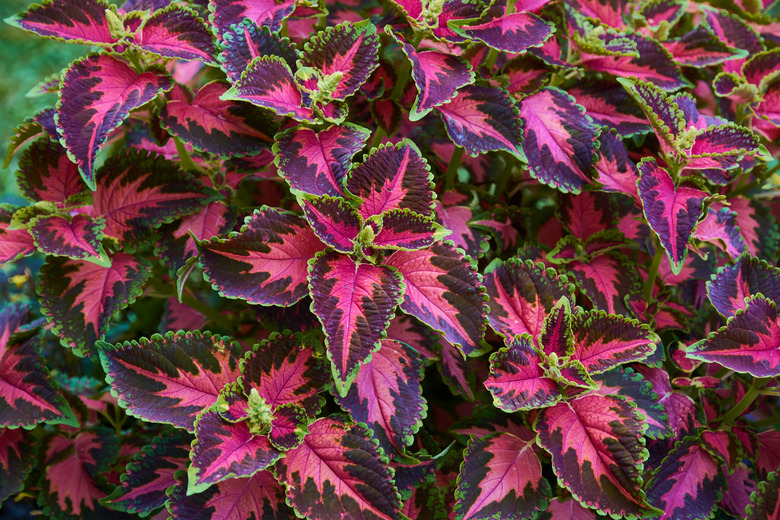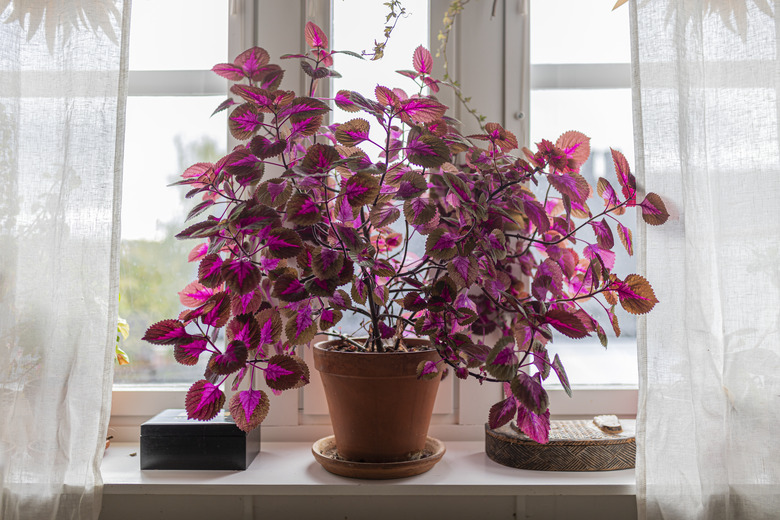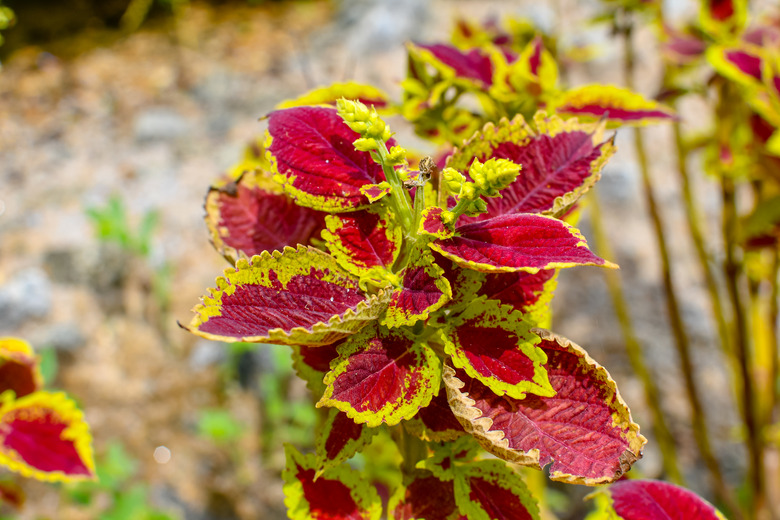How To Grow Coleus
We may receive a commission on purchases made from links.
Flowers are great, but there is also much to say in favor of coleus plants (Coleus scutellariodes, formerly Plectranthus scutellarioides, USDA zones 10-11) and their magnificent colorful foliage. From mild to wild, coleus plants are available in many cultivars featuring everything from plain but pretty pink leaves to multicolored stunners with various shades of green and purple on each leaf. They come in upright, rounded and trailing varieties, all of which look great.
Coleus plants work well in flower beds but also perform extremely well in containers. If you find one whose coloring you absolutely love, consider planting it in a container so you can easily move it indoors and keep it alive over the winter months. Coleus plants are perennials only in the hot climates of USDA zones 10 and 11, but they're grown as annuals in all zones. Since they do not tolerate cold weather well at all, overwintering them indoors is the only way to save a plant you truly adore.
You also have the option of growing coleus plants indoors year-round, as they make beautiful houseplants. Of course, you can also let nature take its course and find new coleus plants to love next spring.
Best Uses for Coleus
Best Uses for Coleus
Although often thought of as a shade-loving plant, it's important to remember that there are over 600 cultivars of coleus from which to choose. Many do like full shade or part sun but don't rule out sun-tolerant coleus cultivars if you have a sunny spot to fill in your garden.
Upright and rounded coleus varieties make great border and foundation plants, while trailing coleus looks beautiful spilling over the side of a container or hanging basket. These colorful plants work well in groups or when used to complement or even contrast other plants. Group plantings of coleus are quite beautiful, but a single plant can provide a burst of unexpected color when put in just the right place.
Many coleus plants do sprout tall flower stalks late in the summer, but their blooms are small and unremarkable. Most gardeners cut them away to extend the life of the plant and encourage more leaves.
How to Grow Coleus
How to Grow Coleus
- Common Name: Coleus
- Botanical Name: Coleus scutellarioides
- When to Plant: After the season's last frost in the spring
- USDA Zones: Annual plant; perennial in zones 10 and 11
- Sun Exposure: Full or part sun depending on the variety
- Soil Type: Moist, well-drained soil
- When it's in Trouble: Brown leaf spots, stunted growth, yellow color
- When it's Thriving: Produces healthy, colorful leaves in vibrant shades
Starting Coleus From Seed
If a trip through the garden center takes you past a few lovely young coleus plants, don't hesitate to buy them and plant them in your garden. Many gardeners grow their coleus from seed, however, as doing so is easy and inexpensive.
To do so, fill a seed tray with seed mix about six to eight weeks before the last expected frost in your area. Sow your coleus seeds in the tray. These seeds are pretty small, so just sprinkle a few all around the seed tray and then barely cover them with potting soil. Gently water the seeds and place them on a sunny windowsill where the temperature will stay between 65 and 85 degrees Fahrenheit.
If you lack a sunny-enough window, you can supplement the light your plants receive with a grow light. Keep the seedlings 3 to 4 inches below the light and leave it on for 16 hours a day. Turn off the light for eight hours each night.
Keep the soil moist but not soggy or wet until your seedlings emerge in 12 to 21 days. When the seedlings get big enough that they have two sets of true leaves, thin them so that you only have one plant per cell in your seed tray. Continue watering your young plants as needed until you can move them outside or into their permanent container.
Starting Coleus From a Seedling
Whether you've grown your own seedling or bought a nursery plant, the planting process is the same. Work and loosen the soil in your planting location to a depth of 8 inches, working in some aged compost if you know your soil is compacted and/or lacks nutrients. When the soil is ready, dig a planting hole large enough to accommodate the root ball of your coleus plant.
Place the plant in the hole after gently teasing apart some of the roots. This will encourage your coleus to stretch out in its new surroundings. Backfill the hole, covering the plant's roots completely and seating the base of your plant level with the soil surface. Handle your coleus plants very gently during planting, as their tender stems are prone to breaking.
Water your new plant well after you plant it. If you're planting multiple coleus plants, space them about 12 inches apart.
In What Zone Does Coleus Grow Best?
In What Zone Does Coleus Grow Best?
Coleus is technically an evergreen perennial. In most of the United States, gardeners use coleus as an annual since this tender perennial doesn't tolerate frost at all and doesn't survive our winters. The exception to this rule is U.S. Department of Agriculture plant hardiness zones 10 and 11. In these zones, coleus can grow as an evergreen perennial.
When Should You Plant Coleus?
When Should You Plant Coleus?
Coleus does not tolerate frost at all, so wait to plant in the spring after the danger of frost passes completely. Ideally, you should wait to plant until the nighttime temperature of your soil is at least 50 degrees Fahrenheit. If you're not sure of your soil's temperature, wait until the air temperature in the evening stays around 60 degrees.
Soil, Sunlight and Water Recommendations for Coleus
Soil, Sunlight and Water Recommendations for Coleus
Great for both beginners and seasoned gardeners alike, coleus plants are easy to grow and require very little attention. Coleus likes a soil pH between 6.0 and 7.0, but it's not overly finicky. Some varieties like part shade, while others like more sun. The best planting locations often have lots of morning sun but dappled shade in the afternoon.
If you're not sure what your particular plant will like, take note of its leaves. Generally, plants with dark leaves like more sun, while plants with lightly colored leaves are more susceptible to leaf scorch when planted in the sun.
Coleus planted in the ground needs watering whenever the top inch of soil is dry. The same is true of coleus planted in containers but remember that containers dry out quickly. You may need to water every other day or more frequently if you're growing your coleus in a pot.
Most plants can benefit from a bit of fertilizer, and coleus is no exception. When overfertilized, however, coleus plants lose their luster and vibrancy, producing much duller and more muted leaves. To prevent this, fertilize regularly but sparingly. The best course of action is to choose a liquid fertilizer that you like and feed your plants as often as the fertilizer label directs. But when you do fertilize, dilute the fertilizer to half the recommended strength to make sure you don't overdo it.
Some gardeners opt to regularly pinch off new shoots growing on their coleus plants. This practice does promote bushier, fuller plants, but it's not necessary. Your plant will do fine if left to its own devices. If you like a more compact plant, grow rounded varieties rather than upright ones.
Your coleus may sprout long flower spikes during the growing season, usually doing so late in the summer. You can leave the flowers if you like them, but they're not particularly showy or fragrant. Many coleus growers opt to prune them off to promote more leafy growth and hopefully extend the life of their coleus a bit.
How to Propagate Coleus
How to Propagate Coleus
Coleus plants are inexpensive and easy to find, so most gardeners don't bother to propagate them. Doing so is easy, however, so you can certainly do so if you have a particular plant you love and want to clone.
To propagate your coleus, simply snip 4 to 5 inches off the top of a healthy stem and remove the leaves on the lower half of the stem. Place the cutting in a glass of water, or into potting mix that you keep moist. When it sprouts roots, transplant it into a small pot of soil. Your young plant will be ready to move outside in the spring.
How to Winterize Coleus
How to Winterize Coleus
As winter approaches, you have two choices for dealing with your coleus plants. The first is to simply let them die, knowing you can plant more next spring. The other option is to bring them inside. If you keep the plant warm inside your home for the winter, it will stay green and vibrant all winter long and can go back outside in the spring.
You can dig up landscape plants to pot them in containers so you can move them indoors. When you do, just remember that coleus stalks are delicate and break easily, so you'll need to handle your plants carefully. If you know in the spring that you plan to keep your plants over the winter, it's easiest simply to plant them in containers to begin with.
If you bring your plant inside, you need to keep it at around 70 degrees so it can keep growing as it did in the summer. You'll also need to make sure it gets plenty of light. Coleus doesn't go dormant. It either keeps growing or dies off, so don't tuck it in a cool basement or garage thinking it will bounce back in the spring. Many plants will, but coleus won't.
You may notice your plant dropping a few leaves when you first move it indoors. This is normal and not cause for concern. If the edges of your coleus plant's leaves start to turn brown, sit it on a tray of pebbles and water to increase the humidity level around the plant.
Common Pests and Other Problems for Coleus
Common Pests and Other Problems for Coleus
Coleus has no unique insect pests, but it can be affected by the usual suspects found in almost every garden. One of these insects is the aphid — small red, black, green or tan insects that suck the juice from plant leaves. Ladybugs often control aphid populations, but if you see aphids on your plants, you can also blast them away with a spray of water from your garden hose or treat them with insecticidal soap.
Mealybugs and spider mites can also be an issue. Mealybugs are waxy white bugs that leave behind cottony-looking residue. Spider mites also leave behind cottony-looking webs, and although they are small, they do look like tiny spiders up close. Mealybugs and mites have the same natural predators as aphids, and you can treat them in the same way.
Slugs and caterpillars also visit coleus from time to time and munch on the leaves, leaving behind holey leaves. The easiest way to deal with these wingless insects is to sprinkle diatomaceous earth around your plants.
Common Diseases of Coleus
Common Diseases of Coleus
Coleus plants are quite hardy, and most home gardeners grow them without incident year after year, but coleus plants can fall prey to the impatiens necrotic spot virus (INSV). The virus is difficult to identify since it manifests in an extremely wide array of symptoms, including stunted plant growth, wilting, sunken leaf spots, etched spots on leaves, poor flowering and plant yellowing.
If you suspect your plant has INSV but you're not sure, talk to your local extension office. If it's determined that your plant does have INSV, know that there is no cure. The best course of action is to remove and destroy the plant.
Like most plants, coleus is also susceptible to downy and powdery mildews. Powdery mildew makes the plant look as if someone covered it in bread flour. Downy mildew, in contrast, affects the undersides of the plant's leaves, causing yellow or gray splotches.
You can avoid both fungi by properly spacing your plants to provide good airflow, avoiding overhead watering and staying away from your coleus plants when they are wet. Neem oil is typically the best treatment for powdery mildew, while copper fungicides work best on downy mildew.
References
- Gardener's Supply Company: How to Grow Coleus
- The Old Farmer's Almanac: Soil pH Levels for Plants
- The Old Farmer's Almanac: Growing Coleus
- Burpee: Learn About Coleus
- University of Minnesota Extension: Coleus > Leaves > Discolored Leaves
- PennState Extension: Impatiens Necrotic Spot Virus
- UC Nursery and Floriculture Alliance: Management of Downy and Powdery Mildews: Three New Diseases Hit California


